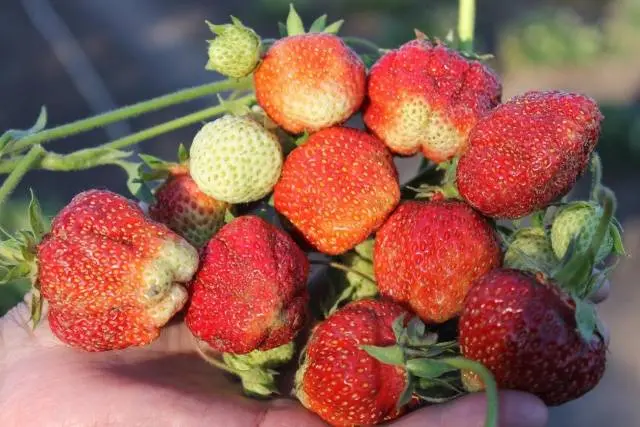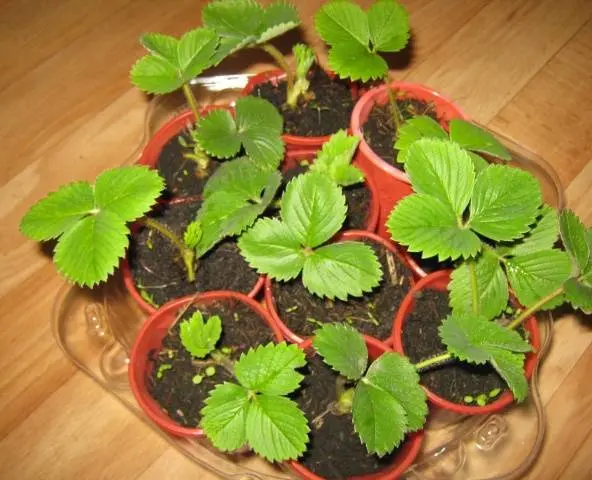Contents
It is generally accepted that it is extremely difficult to grow a berry like strawberries on your own: this requires suitable conditions, good care, fertilizers, frequent watering, and much more. But most importantly, most gardeners consider the climate of their region unsuitable for growing sweet berries. To date, breeders have bred dozens of varieties that are unpretentious to weather conditions, soil composition and do not require much attention from the gardener. One of these species is the variety Elephant. This strawberry is a great option for beginner summer residents, as well as for those who live in cold regions.

A detailed description of the strawberry variety Elephant, photos and reviews about it can be found in this article. Here we will talk about the advantages of resistant strawberries, some of its disadvantages and how to properly grow the Elephant variety in a temperate climate.
Characteristics of a large-fruited species
The strawberry variety Elephant is relatively young – it was selected at the end of the last century. Scientists from the Siberian Research Institute were engaged in breeding a new species, so it is not surprising that The main advantage of the Elephant variety is its strong frost resistance.

Full description of the variety Elephant:
- berry ripening time – medium;
- bushes are powerful, well branched, erect;
- mustache formation is active, shoots are painted in a pale pink hue;
- the variety Elephant can be propagated by seeds, mustaches, dividing the bush;
- the leaves on the bushes are painted in a rich green hue, have a slightly concave shape and are covered with a silvery coating;
- the edge of the sheet is jagged;
- inflorescences are painted white or cream, flowers are medium in size, bisexual (that is, Elephant does not need pollinators);
- peduncles of medium size, sprawling, many-flowered;
- strawberries Elephant baby are large, the average weight is 20-28 grams;
- the fruit does not have a neck, its shape resembles an egg, in the lower part the strawberry is often forked;
- the outside of the strawberry is bright red, the pulp of the berry is also scarlet, dense, the surface is glossy;
- Elephant’s taste is characterized as sweet with a slight sourness;
- the aroma of the berries is very rich, well pronounced “strawberry”;
- strawberries of this variety have a perfectly balanced content of sugars, acids and vitamin C;
- the tasting evaluation of the fruits of the Elephant variety is 4,7 points;
- the yield of strawberries is high – about 200 grams per bush or 0,8 kg per square meter (on an industrial scale – up to 90 centners per hectare of fields);
- the first berries are larger (up to 40 grams) and leveled, subsequent harvests give a smaller crop, such strawberries can have any shape;
- the variety is considered unpretentious and resistant;
- the frost resistance of the Elephant is very good (strawberries winter without shelter even in the central regions of Our Country and in some northern regions);
- in conditions of high humidity, bushes and berries can be affected by gray rot;
- strawberries are unpretentious to agricultural technology, but for poor care they can “thank” with small and sour berries;
- the purpose of the variety is universal: Elephant calf is also good fresh (as it is considered a dessert variety), the berry is suitable for preservation, making jams, jams and marmalade, it tolerates freezing well.

Among other things, Elephant’s strawberry perfectly tolerates drought, so it can be safely planted not only in Siberia, but also in the more southern and hotter regions of the country.
Advantages and disadvantages
If the breeders managed to develop the ideal variety, new types of strawberries would no longer appear. Baby elephant, like other varieties of sweet berries, has both strengths and weaknesses.
The advantages of this strawberry include:
- large and beautiful berries;
- excellent aroma and pleasant taste of fruits;
- very good frost resistance;
- unpretentiousness;
- the possibility of growing in arid and cold regions;
- high productivity.

The Siberian variety also has some disadvantages, among them:
- high risk of strawberry rot in conditions of high humidity;
- strong dependence of the quality of berries on the amount of fertilizer and irrigation;
- dense, not too juicy pulp.
Despite the listed disadvantages, the variety is quite popular not only among private gardeners and summer residents, the Elephant is often grown by farmers. Reviews of gardeners about this strawberry, for the most part, are positive: they love it for productivity and large-fruitedness. And dense berries tolerate transportation better, so they are great for commercial purposes.
Agrotechnical rules
Strawberry Elephant, indeed, is an unpretentious variety. But, as mentioned earlier, she is sensitive to lack of care: the quality and quantity of the crop is noticeably reduced.

In order for the strawberries of the Elephant variety to grow as in the photo, the gardener must make a lot of effort. And you should start with the correct planting of strawberry seedlings.
Rules of landing
A place for strawberry beds is chosen sunny and protected from drafts. It is impossible for the site to be in a lowland, since moisture can collect there, and for the Elephant its excess is fatal.
Good strawberry seedlings have a healthy appearance, a dense stem and long, branched roots. Plants with 3-4 true leaves are suitable for planting.

You can plant an Elephant both in spring and autumn – to choose the right time, the gardener must take into account the climate in his region. If the winters are not very severe, snowy and thawless, it is better to plant strawberry seedlings in the fall. So the Baby Elephant will have more chances to go deep into the ground normally and put down good roots. When planting in the autumn next season, you can expect the first harvest of large berries.


A month before planting, ammonium nitrate, humus, wood ash are introduced into the soil. If the acidity of the soil is high, it is necessary to reduce it by adding a little quicklime – the Baby Elephant does not like soil with a pH level of more than six.
Two weeks later, the area under the strawberries is dug up on the bayonet of a shovel, having previously scattered superphosphate and potassium chloride over it. Now you can make holes for seedlings, leaving a distance of 20 cm between them. The row spacing should be convenient for the gardener, usually leave about 80 cm. It remains to pour the holes with warm water and plant strawberries, compacting the ground around its roots.
Care steps
You need to care for the Elephant calf variety carefully and regularly. The main steps in caring for strawberry beds should be the following:
- Frequent and plentiful watering, because the Baby Elephant loves moisture very much. Be sure to keep in mind that excess moisture can lead to strawberry rot. Therefore, it is recommended to water the bushes with drip systems. Water for irrigation is taken warm, and the time is chosen in the evening.
- To reduce the number of waterings, it is necessary to use mulch (straw, humus, peat, sawdust). Mulch will prevent the soil from drying out and prevent weeds and pests from multiplying. In autumn, it is recommended to remove the mulch layer and burn it, as it can become a source of bacteria and viruses.

- Large-fruited strawberries must be fertilized, otherwise the berries will be small and not so tasty. It is necessary to feed the bushes several times during the season, while in the summer it is recommended to use mineral complexes, and to use organic matter in the autumn-winter period. For Baby Elephant, feeding with humus, compost, wood ash, potassium phosphate complexes is good.

- To prevent infection of strawberries with rot and fungal diseases, it is recommended to treat the bushes with Bordeaux liquid or a solution of copper oxychloride. It is better to fight insects with the help of special chemicals. At the stage of fruit formation, “chemistry” is undesirable, it can be replaced with folk remedies (for example, vegetable oil + wood ash + vinegar + liquid soap).

- For the winter, it is better to mulch the Elephant’s bushes with pine needles. This material perfectly protects the roots from freezing, allows air to pass through, allowing strawberries to breathe during the thaw period, and does not contribute to the reproduction of insects and infections.

Write Your Review
Conclusion
Variety Elephant is perfect for those who live in a region with a difficult climate: this strawberry perfectly adapts to both cold and heat, can withstand both drought and excess moisture.

Despite its non-repairability, the Baby Elephant pleases with abundant harvests – during the season, good owners manage to collect up to 2,5 kg of beautiful and tasty berries from each bush.












